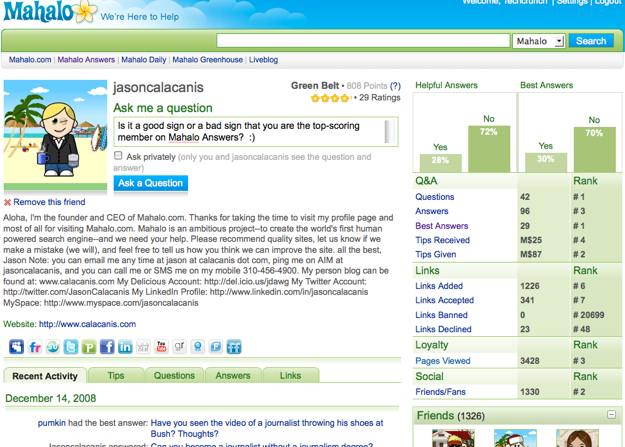Mahalo is now answering your questions. The human-curated search engine/ condensed wiki guide is adding a Q&A service called Mahalo Answers to its mix. It is a combination of Yahoo Answers and the long-defunct Google Answers, with some cute avatars and virtual currency thrown in. (Disclosure: Mahalo CEO Jason Calacanis is our partner in the TechCrunch50 conference).
Like Yahoo Answers, anyone can ask or answer any question. But Mahalo Answers throws in a twist. If someone really wants to encourage the best answers, they can offer a tip in “Mahalo Dollars,” which can be funded through PayPal and are convertible into real dollars once a member has earned at least 40 of them. For those of you who remember Google Answers, it paired questioners with vetted researchers who found answers for a fee. This is slightly different in that questions are not assigned to a specific researcher. As many people can answer it as they want and all compete for the tip. Furthermore, the tip can be rescinded by the questioner if he or she is not satisfied with any of the answers.
To keep people honest, there is a reputation system. If a tip is withheld, you have to explain why. Reneg on too many tips, and nobody will want to answer any of your questions.
There is also a point system. Calacanis says he was inspired by many of the gaming startups at TechCrunch50, and how they were designed to keep players engaged by getting them to constantly level up. On Mahalo Answers, you get points for asking questions, answering them, providing the “best” answers, as well as adding links and gaining friends. (And guess who is the member with the most points accumulated during the closed beta? Calacanis).
As you get more points, you progress through different belt levels (white, yellow, green, etc.). It’s like a game. The higher belt you have, the more of an “expert” you are. One of the features of the site is that people can ask members direct questions. The more points you have, the more you can charge for your answers. Mahalo takes a 25 percent cut when Mahalo Dollars are converted back into regular currency Calacanis says:
If you can make knowledge into a game and help people make living, it is very powerful.
He considers Mahalo Answers to be the third plank of his company’s strategy, with human-powered search and abbreviated wiki guides being the first two. When someone answers a question, they are encouraged to add links, photos, and videos as part of their answer. Mahalo harvests all of those links, and the best answers become part of its topic guides. “The question and answer service becomes a way to make our guide better,” says Calacanis. That is, if enough people use it.
Mahalo is essentially paying for traffic here, or rather getting its users to pay for traffic. The prospect of making tips from other users will be the main draw for many visitors. The question is: Will that be enough to jumpstart more organic growth by improving upon the Q&A format and seeding the site with some really good answers? Or does Yahoo Answers with its 154 million monthly unique visitors worldwide (comScore) have too much momentum to ever be challenged?

